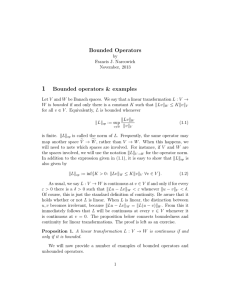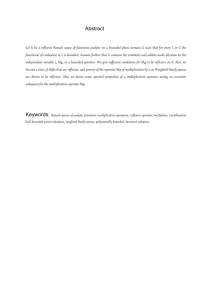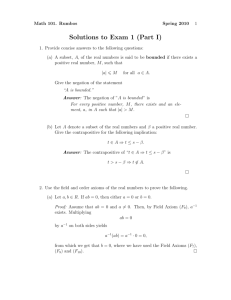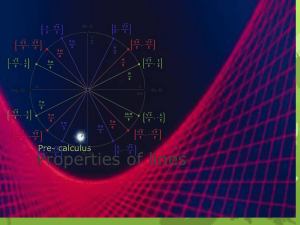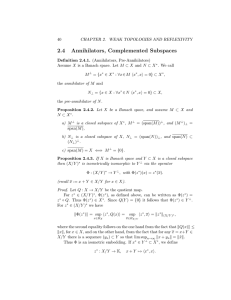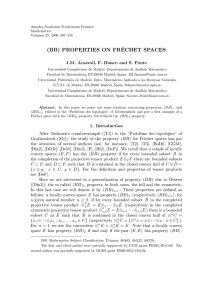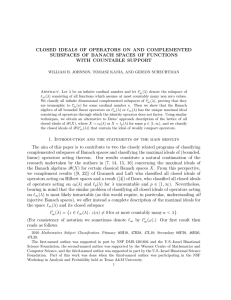1 Bounded Operators & Closed Subspaces Bounded operators & examples
advertisement
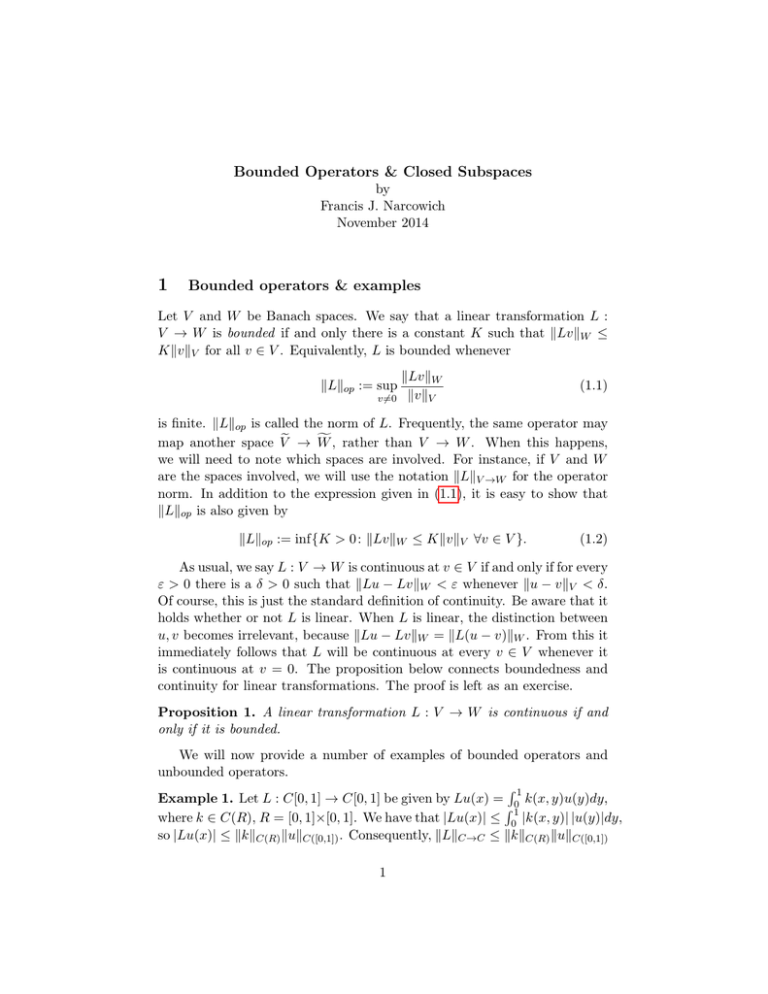
Bounded Operators & Closed Subspaces
by
Francis J. Narcowich
November 2014
1
Bounded operators & examples
Let V and W be Banach spaces. We say that a linear transformation L :
V → W is bounded if and only there is a constant K such that kLvkW ≤
KkvkV for all v ∈ V . Equivalently, L is bounded whenever
kLkop := sup
v6=0
kLvkW
kvkV
(1.1)
is finite. kLkop is called the norm of L. Frequently, the same operator may
f , rather than V → W . When this happens,
map another space Ve → W
we will need to note which spaces are involved. For instance, if V and W
are the spaces involved, we will use the notation kLkV →W for the operator
norm. In addition to the expression given in (1.1), it is easy to show that
kLkop is also given by
kLkop := inf{K > 0 : kLvkW ≤ KkvkV ∀v ∈ V }.
(1.2)
As usual, we say L : V → W is continuous at v ∈ V if and only if for every
ε > 0 there is a δ > 0 such that kLu − LvkW < ε whenever ku − vkV < δ.
Of course, this is just the standard definition of continuity. Be aware that it
holds whether or not L is linear. When L is linear, the distinction between
u, v becomes irrelevant, because kLu − LvkW = kL(u − v)kW . From this it
immediately follows that L will be continuous at every v ∈ V whenever it
is continuous at v = 0. The proposition below connects boundedness and
continuity for linear transformations. The proof is left as an exercise.
Proposition 1. A linear transformation L : V → W is continuous if and
only if it is bounded.
We will now provide a number of examples of bounded operators and
unbounded operators.
R1
Example 1. Let L : C[0, 1] → C[0, 1] be given by Lu(x) = 0 k(x, y)u(y)dy,
R1
where k ∈ C(R), R = [0, 1]×[0, 1]. We have that |Lu(x)| ≤ 0 |k(x, y)| |u(y)|dy,
so |Lu(x)| ≤ kkkC(R) kukC([0,1]) . Consequently, kLkC→C ≤ kkkC(R) kukC([0,1])
1
Example 2. Hilbert-Schmidt operators.
Definition 1. Let R = [0, 1] × [0, 1] and let k : R → R. If k ∈ L2 (R), then
k is called a Hilbert-Schmidt kernel.
Proposition
kernel. The linear operator
R 1 2. Let k be a Hilbert-Schmidt
2
2
Lu(x) = 0 k(x, y)u(y)dy maps L [0, 1] → L [0, 1] and is bounded. Moreover, kLkL2 →L2 ≤ kkkL2 (R) .
Proof. Step 1. We will first show that k(x, y)u(y) ∈ L1 (R). To see this,
observe that, by Schwarz’s inequality,
Z
1Z 1
1Z 1
Z
kkukL1 (R) =
0
0
1/2
|u(y)| dxdy
|k(x, y)u(y)|dxdy ≤ kkkL2 (R)
0
2
0
≤ kkkL2 (R) kukL2 [0,1] .
Consequently, k(x, y)u(y) ∈ L1 (R).
Step 2. By Fubini’s theorem, k(x, y)u(y) ∈ L1 (R) implies that the double
integral and both iterated integrals
of k(x, y)u(y) over R exist and are equal.
R1
In particular, we have that 0 k(x, y)u(y)dy is an L1 function of x; thus,
Lu(x) is defined a.e. on [0, 1] and is in L1 [0,R1].R
1 1
Step 3. Because k ∈ L2 (R), the integral 0 0 |k(x, y)|2 dxdy = kkk2L2 (R)
is finite.
y)|2 ∈ L1 (R). The Fubini-Tonelli Theorem then implies
R 1 Thus |k(x,
2
that 0 |k(x, y)| dy is in L1 [0, 1] as a function of x. Thus, applying Schwarz’s
inequality to Lu(x) yields
Z
|Lu(x)| ≤ 1
2
0
2
Z
|k(x, y)|u(y)|dy ≤ kuk2L2 [0,1]
1
|k(x, y)|2 dy.
0
R1
Since 0 |k(x, y)|2 dy is L1 in x, the left-hand side is, too. Integrating both
sides above yields
Z 1
Z 1Z 1
2
2
2
kLukL2 [0,1] =
|Lu(x)| dx ≤ kukL2 [0,1]
|k(x, y)|2 dydy
0
=
0
0
2
2
kukL2 [0,1] kkkL2 (R)
It follows that Lu ∈ L2 [0, 1] and kLkL2 →L2 ≤ kkkL2 (R) .
d
Example 3. Let H = L2 [0, 1]. The differentiation operator D = dx
is
1
defined on all f ∈ C [0, 1], which is dense in H because it contains the set
of polynomials. The question is whether D is bounded, or at least can be
2
extended
to a bounded operator on H. The answer is no. Let un (x) :=
√
1
2 sin(nπx). These
√ functions are in C [0, 1] and they satisfy kun kH = 1.
Since Dun = nπ 2 cos(nπx), kDun kH = nπ. Consequently,
kDun kH
= nπ → ∞, as n → ∞.
kun kH
Thus D is an unbounded operator.
The situation changes if we use a different space. Consider the Sobolev
space H 1 [0, 2π] := {f ∈ L2 [0, 2π] : f 0 ∈ L2 [0, 2π], where f 0 isRcomputed in a
2π
distributional sense. H 1 [0, 2π] has the inner product hf, gi = 0 f (x)g(x)dx.
The operator D : H 1 → L2 turns out to be bounded. In fact, kDkH 1 →L2 = 1.
2
Closed subspaces
The usual definition of subspace holds for Banach spaces and for Hilbert
spaces. Such subspaces inherit norms and/or inner products from the larger
spaces. They are said to be closed if they contain all of their limit points.
Finite dimensional subspaces are always closed. Earlier, when we dis∞
cussed completeness of an orthonormal set U = {u
Pn }n=1 in a Hilbert space
H, we saw that the space HU = {f ∈ H : f = n hf, un iun } is closed in
H. When C[0, 1] is considered to be a subspace of L2 [0, 1], it is not closed.
However, C[0, 1] is a closed subspace of L∞ [0, 1].
Given a subspace V of a Hilbert space H, we define the orthogonal complement of V to be
V ⊥ := {f ∈ H : hf, gi ∀g ∈ V }.
Proposition 3. V ⊥ is a closed subspace of H.
⊥ that converges to a function f ∈ H.
Proof. Let {fn }∞
n=1 be a sequence in V
⊥
Since each fn is in V , hfn , gi = 0 for every g ∈ V . Also, because the inner
product is continuous, limn→∞ hfn , gi = hf, gi. It immediately follows that
hf, gi = 0. so f ∈ V ⊥ . Consequently, V ⊥ is closed in H.
Bounded linear operators mapping V → W , where V and W are Banach
spaces, have all of the usual subspaces associated with them. Let L : V → W
be bounded and linear. The domain of L is D(L) = V . The range of L is
defined as R(L) := {w ∈ W : ∃v ∈ W for which Lv = W }. Finally, the null
space (or kernel) of L is N (L) := {v ∈ V : Lv = 0}.
Proposition 4. If L : V → W be bounded and linear, then the null space
N (L) is a closed subspace of V .
3
Proof. The proof again relies on the continuity of L. If {fn }∞
n=1 is a sequence
in N (L) that converges to f ∈ V . By Proposition 1, L is continuous, so
limn→∞ Lfn = Lf . But, because fn ∈ N (L), Lfn = 0. Combining this with
limn→∞ Lfn = Lf , we see that Lf = 0 and so f ∈ N (L). Thus, N (L) is a
closed subspace of V .
Previous: X-ray tomography and integral equations
Next: the projection theorem, Reisz representation theorem and the Fredholm alternative
4
